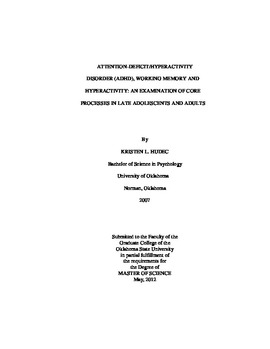| dc.contributor.advisor | Alderson, Robert Matthew | |
| dc.contributor.author | Hudec, Kristen | |
| dc.date.accessioned | 2014-04-15T22:23:44Z | |
| dc.date.available | 2014-04-15T22:23:44Z | |
| dc.date.issued | 2012-05-01 | |
| dc.identifier.uri | https://hdl.handle.net/11244/9428 | |
| dc.description.abstract | Attention-Deficit/Hyperactivity Disorder (ADHD) was originally conceptualized as a disorder of childhood, but updated research provides evidence that symptoms continue into adulthood, suggesting ADHD occurs in four to five percent of the adult population. Studies of symptom course across the lifespan have been equivocal, but executive function deficits, particularly in working memory, have been shown to persist. The working memory model of ADHD suggests that increased activity is functionally related to increased demands on the working memory system, and this connection has been supported in children. The current study examined whether objectively-measured activity level differs between young adults with ADHD and typically developing (TD) adults and whether motor activity is functionally related to working memory (WM) demands. Clinical diagnostic procedures were utilized to assign undergraduate participants into ADHD and TD groups. Actigraphs were used to obtain a measure of overall movement during phonological (PH) and visuospatial (VS) working memory tasks and control conditions. All participants exhibited greater activity during phonological WM conditions compared to control conditions, yet participants in the ADHD group exhibited disproportionately greater changes in activity level compared to TD participants during visuospatial WM conditions relative to control conditions. Latent variable analysis was used to determine that activity level associated with the central executive was significantly greater in the ADHD group. Current results indicated that adults with ADHD were more active than TD controls, supporting the notion that excessive activity related to ADHD continues into adulthood. Activity differences between modalities contradict findings with children, perhaps due to developmental changes or methodological variables. This study is the first to demonstrate a functional relationship between ADHD-related activity and working memory demands, particularly on the central executive, in adults. Results are consistent with findings in children and refute the notion that excessive activity is a ubiquitous feature of ADHD unrelated to task demands. | |
| dc.format | application/pdf | |
| dc.language | en_US | |
| dc.publisher | Oklahoma State University | |
| dc.rights | Copyright is held by the author who has granted the Oklahoma State University Library the non-exclusive right to share this material in its institutional repository. Contact Digital Library Services at lib-dls@okstate.edu or 405-744-9161 for the permission policy on the use, reproduction or distribution of this material. | |
| dc.title | Attention-Deficit/Hyperactivity Disorder (Adhd), Working Memory and Hyperactivity: an Examination of Core Processes in Late Adolescents and Adults | |
| dc.type | text | |
| dc.contributor.committeeMember | Mullins, Larry L. | |
| dc.contributor.committeeMember | Grant, DeMond M. | |
| osu.filename | Hudec_okstate_0664M_12120.pdf | |
| osu.college | Arts and Sciences | |
| osu.accesstype | Open Access | |
| dc.description.department | Department of Psychology | |
| dc.type.genre | Thesis | |
